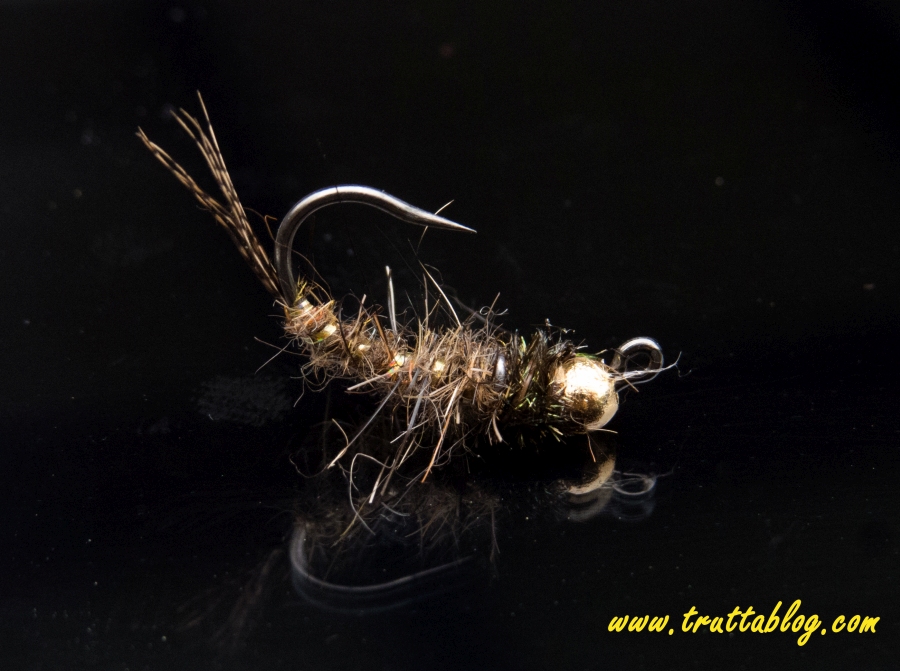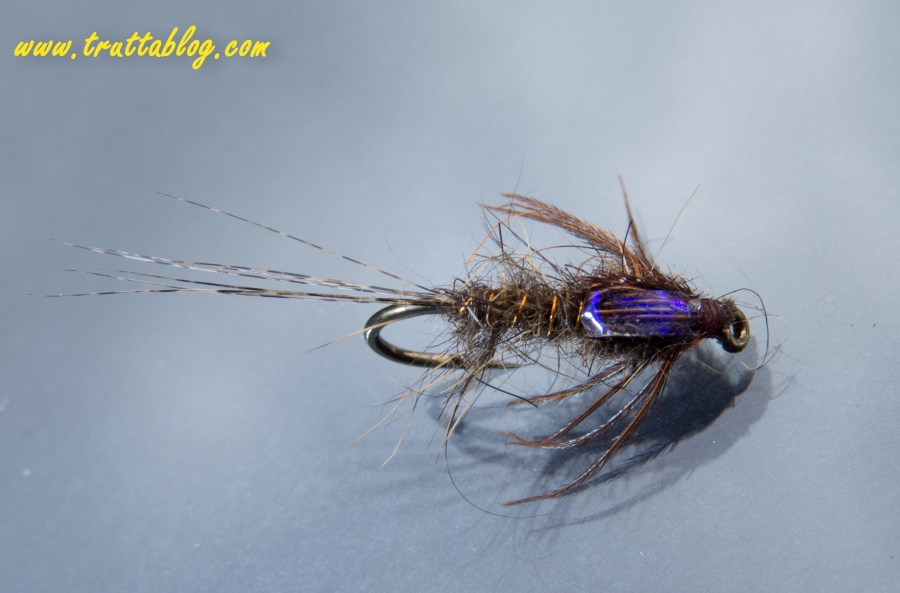The dog has a squeaky toy that is just too much. He is enthralled with the incessant high-pitched excitement of it all, and will stand there chewing irritation into my ear without pause. So the other day I took squeaky Nemo, and put it inside his giant orange rubbery bell-shaped toy that we kick around the garden for him. Now it has a muted and muffled squeak. A pleasant shadow of its former self. And the red Nemo, nestled inside the translucent orange orb, is, I realised this morning, now a Trout egg.
Voila.
Hiding Nemo got me thinking about hiding beads. A friend of mine says he is a salmon…always swims against the current, and I suppose that when it comes to fly design, I am like that too. I have devised some pretty crazy (and unsuccessful) ideas over the years.

Beads are now ubiquitous. They are on everything, to the point of being boring, and sometimes ridiculous. I see what looks like a dry fly, with genetic hackle, and CDC, and then someone has stuck a 4mm bead on it. The other day there was a challenge to get guys to fish with just a beaded hook, nothing else, and see what they could catch. Now this is little different to Oliver Kite’s bare hook nymph. That thing was a hook with some copper wire wound roughly onto it. Kite caught plenty of fish on that, and while I haven’t seen the results, I know that plenty of fish will come to the naked bead too. But since my flyfishing is at once an aesthetic experience and a conquest, I choose to catch on a fly which I like the look of, whether it is necessary or not. I guess that is the difference between a quantitative and a qualitative flyfishing experience. There are elements of this that matter because I make them matter, not because the Trout demand it.
The other day, while I was travelling, I got hungry, and I opened a plastic container full of rusks which I had on the front seat. Now the container I had put them in, once held washing powder. It had been through the dishwasher several times, but while I was chewing my first rusk, I got this distinct scent of Omo. I took a sniff at the rusk: clear fresh laundry smell. I took a sniff at the container: clear fresh laundry smell. I tasted the rusk: Clear Ouma. Did I keep eating it? NO! Omo just isn’t Ouma. My mind couldn’t bring me to eat it any more than I could throw a Mepps spinner into a Trout river.
So what if I hide the bead in the fly dressing? I mean, we all know that an orb of tungsten does wonders for getting down to what the neophytes now call the “strike zone”, and little else is as dense and effective, but do we have to have a bead on everything? And if we don’t put a bead on a nymph, and as a result it doesn’t get down to where we want it, do we hide a bead in the dressing, or do we bite a split shot onto the tippet? And which one of those is acceptable? Is the bead honourable if you don’t tell your fishing buddy, and if he can’t see it in the fly pattern? I sometimes use a tungsten bead in the point position, on a loop of nylon (sans hook), in what I later learnt is called “drop shot nymphing”. I didn’t know it had already been invented. Someone once remarked that this practice of mine “isn’t fly fishing”. My critic fishes with an enormous plastic bobber.

And now that a tank with a big “Z” on the side has become the definition of a strike zone, will guys still call the river bed zone by the same name? And I wonder if they will persist with this reference to a morning’s fishing as a “session”, or worse still a “sesh”. And will an obsession with one particular species of flyfishing quarry continue to earn you the label of a snob, and raise the expectation that you will don a deerstalker? And then enter the idea that to catch fish and return them just for the sport of it, is the height of unnecessary cruelty…..second only to shooting fenced-in Lions. But shooting a deer in the a patch of woods hemmed in by roadways is OK, and eating a grasshopper, snail or mollusc is all good. Unless the particular species is about to go extinct, then it is a crime, but any time before that is ‘A-Okay’.
It is all very complicated. I think I will just go kick that Trout egg around the garden for a while, and perhaps clarity will come to me, and I will make sense of it all.
2 Responses
Years ago on the River Avon in Wiltshire, I came upon two young men armed with spinning rods upon which were hanging Mepps spinners). As they were about to launch these unsightly apparitions into the hallowed waters, I interrupted their moment on a chalk stream.
“I think you”ll find”, said I with an irony-laced voice “that the magnanimous gesture of the Piscatorial Society to allow nymphs after 1 July did not extend to Mepps spinners.”
“Ah” they replied, “are we not allowed to fish here? There is no sign designated it as private water.”
“This is England, we don’t need to signs. If you need to know, you know”, I thought but did not say.
In the event, they left with no fuss and the brown trout were saved the ignominy of being caught below the surface as all English trout prefer.
That being said, I am always curious why flies lost in tree’s always seem to be beadheads. Can it be that lost dry flies shed their shucks and become beadheads?
Clem…I like that metamorphosis idea…it seems to make a lot of sense! Coincidentally, I was in a tribal area on the week-end, and locals were telling me about their catches of Browns. When I asked as to their technique, they made it clear that these were Trout and that it was widely understood by all involved that nothing but an artificial fly would do. And for the sceptics….we met two fishermen on the river that day, and both were using flies. In fact one of them was tying his own flies with the feathers from chickens. They were unweighted. I am going to say that Halford would have been proud.